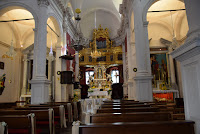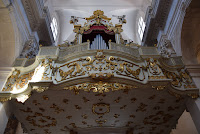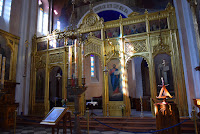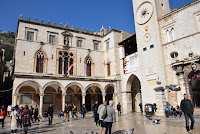I decided to head towards the opposite direction I had walked from and soon came to the Sponza palace, the Rector's Place and St. Blaise's Church. Taking advantage of the fact that this latest mentioned was the only one open I didn't hesitate in briefly visiting it.

The Baroque Church consisting of a single square nave flanked by two sacristies as rather interesting. Its interior wasn't less impressive than the ornate outside façade particularly because of the altar piece in a combination of polychrome marble and a high gilt silver precious niche with the statue of Saint Blaise flanked by two kneeling angels. The statue is siad to have been the only one to survive the 1706 fire.




As I walked out I came across the Onofrio's little fountain dating from the 15th century before having been mesmerizes by the Gothic portico of the Rector's Palace, former seat of the Rector of the Republic of Ragusa from the 14th century through to 1808, whose individual columns I took photos from. Three are said to be in Renaissance style harmoniously combined with the Gothic ones.









I soon after visited the Assumption Cathedral, whose construction was partly due to the financial contribution of Richard the Lion Heart, for having survived a shipwreck near the Lokrum island on his return from the Third Crusade.
Having been largely destroyed in the earthquake if 1667 it was later rebuilt over the next three decades, under the influence of the Roman Barroque architecture esthetics. The high nave is separated by huge massive columns from both ailes. The altar holds a polyptych by Titian portraying the Ascension of Mary, with the side altars with equally valuable paintings by Italian and Dalmatian masters.
I was impressed by some of the outsanding marble side altars, particularly the one dedicated to Our Lady of Port. I didn't see any of the treasury relics I had read about





I soon found myself by the old harbour having taken a narrow back lane, though I didn't stay long. I headed back to the Rector's Palace, which had become my reference before having headed towards the Gunduliceva square, which was filled with tourists, as well as locals. A few metres away and almost "hidden" in one of its back streets the Orthodox Church, which I visited.




Said to have been home to an Orthodox Christian community for centuries, their main place of worship was built in Neo-Byzantine style with squat rectangular bellfries protruding from its rather ornate façade, which inevitably caught one's attention and more so for being set behind wrought- iron railings.

Its interior was impressive mainly because of the carved wooden screen with portraits of saints and the beautifully painted ceiling. There was a rather ceremonial touch type of atmosphere.



I walked back and forth on the Stradun once most of the places I wanted to visit were closed. The cold breeze settled in and despite feeling rather uncomfortable I felt nevertheless unwilling to get back to the hotel.


(To be continued)
































No comments:
Post a Comment